Don’t limit your skiing adventures to the downhill slopes. Try cross-country skiing and explore the beauty of nature with every glide.
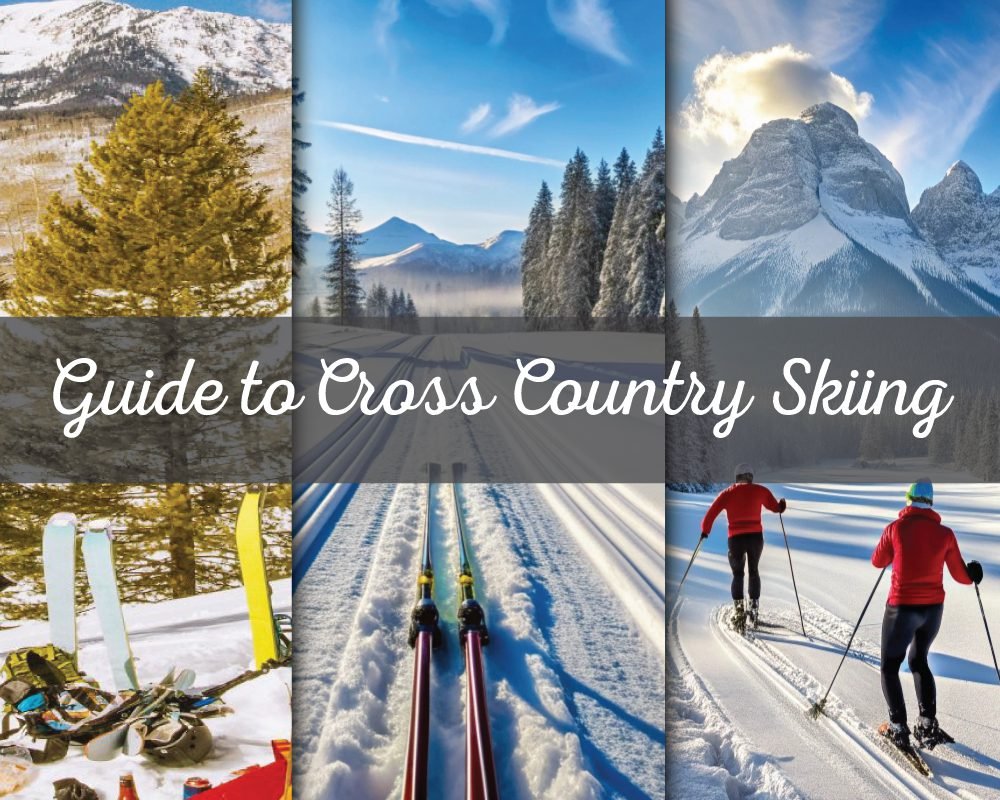
Table of Contents
Getting Started with Cross-Country Skiing
Welcome to the ultimate beginner’s guide to cross-country skiing! In this comprehensive guide, we will cover everything you need to know to get started with this exciting winter sport. Whether you are a complete beginner or have some experience on the slopes, cross-country skiing is a fantastic way to explore the winter wonderland and stay active. So, let’s dive in and discover the world of cross-country skiing!
What is Cross-Country Skiing?
Cross-country skiing, also known as Nordic skiing, is a form of skiing where skiers use their own locomotion to move across snow-covered terrains. Unlike downhill skiing, which focuses on speed and descending slopes, cross-country skiing is about endurance, exploring trails, and enjoying the beautiful scenery.
Types of Cross Country Skiing
1.Classic Cross Country Skiing
Classic cross country skiing is the traditional style of cross country skiing. Skiers use a diagonal stride technique, pushing off with one ski and gliding on the other. This technique is similar to walking or jogging and is suitable for all types of terrain. Classic cross country skiing is great for beginners and those who enjoy a slower pace.
2. Skate Skiing
Skate skiing, also known as freestyle skiing, is a more dynamic and fast-paced style of cross country skiing. Skiers use a side-to-side skating motion, pushing off with the edges of their skis. This technique allows skiers to achieve higher speeds and is often used in competitive racing. Skate skiing requires more technique and balance than classic skiing, making it ideal for intermediate and advanced skiers.
Differences between Classic and Skate Skiing
While both classic and skate skiing are forms of cross country skiing, there are some key differences between the two. Classic skiing involves a linear forward motion, similar to walking or running, while skate skiing involves a side-to-side skating motion. Classic skiing is suitable for all types of terrain and is great for beginners, while skate skiing
Differences between Cross Country Skiing and Downhill Skiing
While both cross country skiing and downhill skiing involve sliding on skis, there are some key differences between the two. Downhill skiing is more fast-paced and adrenaline-pumping, with skiers racing down steep slopes using ski lifts to reach the top. Cross country skiing, on the other hand, is more about endurance and technique, requiring skiers to propel themselves forward using their own muscle power. It is a more relaxed and immersive experience, allowing skiers to appreciate the beauty of nature and the tranquility of the winter landscape.
Terrain: Cross country skiing is typically done on flat or gently rolling terrain, such as trails or groomed tracks. Downhill skiing, on the other hand, is done on steeper slopes and requires a designated ski resort or mountain.
Technique: Cross country skiing involves a more rhythmic and coordinated technique, with a push and glide motion. This technique is used to propel oneself forward on the skis. Downhill skiing requires more use of edges, balancing, and turning techniques to navigate the slopes and control speed.
Equipment: Cross country skis are generally longer and narrower than downhill skis, with a binding that only attaches to the toe of the boot. This allows for the free movement of the heel, which is essential for the push and glide technique. Downhill skis are shorter and wider, providing more stability and control at higher speeds. The bindings also attach to the entire boot, securing the heel and providing more control over the skis.
Speed: Downhill skiing generally involves higher speeds, as skiers are able to gain momentum on steeper slopes. Cross country skiing tends to involve slower speeds, as the focus is more on endurance and technique rather than speed.
Fitness level: Cross country skiing requires a higher level of cardiovascular endurance and overall fitness, as it involves propelling oneself for longer distances and on flatter terrain. Downhill skiing relies more on bursts of strength and agility, with shorter runs and more frequent breaks.
Accessibility: Cross country skiing can be done in various locations, including backcountry areas, parks, or even in urban environments with dedicated ski tracks. Downhill skiing typically requires access to ski resorts or mountains, which may be less available or accessible depending on location.
Cost: Downhill skiing tends to be more expensive than cross country skiing. Ski resorts, lift tickets, and rental equipment can be quite costly. In contrast, cross country skiing can be a more affordable option since it can be done on public trails and with simpler equipment.
Overall, cross country skiing and downhill skiing have different techniques, terrain, equipment, speeds, fitness requirements, accessibility, and costs. Choosing between them depends on personal preferences, goals, fitness level, and available resources.
Why Should Beginners Try Cross-Country Skiing?
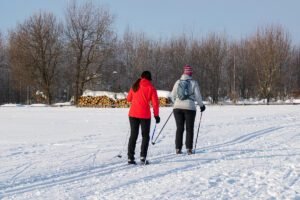
There are several reasons why beginners should try cross-country skiing. Firstly, it is an excellent cardiovascular workout that engages both the upper and lower body muscles. It helps improve cardiovascular fitness, strengthens core muscles, and enhances balance and coordination. Secondly, cross-country skiing allows you to connect with nature and enjoy the tranquility of snowy landscapes. It’s a great way to escape the hustle and bustle of daily life and immerse yourself in nature’s beauty.
What Equipment Do You Need for Cross-Country Skiing?
Before hitting the trails, you’ll need to gather the essential equipment for cross-country skiing. The primary equipment includes skis, boots, and poles. Cross-country skis are longer and narrower than downhill skis, allowing for gliding on flat and uphill terrain. The boots are lightweight, flexible, and provide ankle support. Cross-country ski poles help with propulsion and balance while skiing. It’s essential to choose the right equipment that suits your skill level and the type of skiing you want to pursue.
To go cross-country skiing, you will need the following equipment:
- Skis: Cross-country skis are longer and narrower than downhill skis. They should be selected based on your weight and skiing style. There are classic skis for use on groomed tracks and skate skis for faster, more dynamic skiing on wider, flatter trails.
- Bindings: Bindings are used to attach your boots to the skis. There are several types of bindings available based on the skiing technique and boot compatibility.
- Boots: Cross-country ski boots provide support and insulation. They should be comfortable, lightweight, and have a flexible sole to allow for natural foot movement.
- Poles: Ski poles help with balance, propulsion, and navigation. The length of poles depends on the skiing technique, height, and personal preference.
- Ski Wax: Wax is essential to improve glide and grip on the snow. The type of wax needed depends on the temperature and snow conditions.
- Clothing: Dress in layers to stay warm, dry, and comfortable. Wear moisture-wicking base layers, insulating mid-layers, and a windproof and waterproof outer shell. Don’t forget a hat, gloves, and goggles or sunglasses for protection.
- Backpack: Bring a small backpack to carry water, snacks, and extra layers in case the weather changes.
- Safety Equipment: It’s advisable to carry a map, compass, and a first aid kit when venturing into unfamiliar areas. Additionally, a whistle, headlamp, and a cell phone or emergency communication device can be useful in case of emergencies.
- Optional Accessories: Other accessories you may consider bring include gaiters to protect your lower legs from snow, a ski bag for easier transportation, and a ski waxing bench for maintenance.
Remember to consult with experienced skiers or visit a specialized store to ensure you have the correct equipment for your skill level, terrain, and skiing goals.
Learning the Basic Techniques
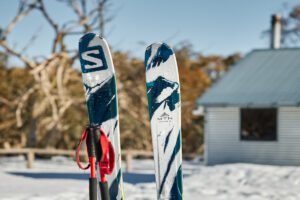
What are the Different Types of Cross-Country Skiing?
There are two main types of cross-country skiing: classic cross-country skiing and skate skiing. Classic cross-country skiing involves a striding movement similar to walking or jogging and is suitable for beginners. Skate skiing, on the other hand, mimics ice skating movements and requires more technique and physical fitness. It’s important to understand the differences between these techniques to choose the one that best suits your preferences and skill level.
How to Glide and Maintain Balance while Cross-Country Skiing?
Glide and balance are key elements in cross-country skiing. To achieve a smooth glide, make sure your weight is evenly distributed on both skis and push off with each stride, extending your leg fully. Maintaining balance requires engaging your core muscles and keeping a relaxed upper body posture. Practice weight shifting and maintaining a stable center of gravity to improve your balance while skiing.
To glide and maintain balance while cross-country skiing, follow these steps:
- Find a comfortable skiing position: Start with your feet hip-width apart and parallel to each other. Bend slightly at the knees and keep your weight centered over the mid-portion of your skis.
- Engage your core: Activate your core muscles by pulling your belly button towards your spine. This will help stabilize your body and maintain balance while skiing.
- Keep your arms and poles engaged: Your arms should be relaxed but engaged. Hold the ski poles with a firm grip and swing them forward and backward in a rhythmic motion to help propel yourself forward and maintain balance.
- Balance your weight: Shift your weight from one ski to the other as you push off and glide. When gliding on one ski, keep most of your weight on the glide ski while the other ski remains light.
- Maintain a forward lean: Lean slightly forward from the ankles, not the waist, to maintain a good skiing posture. This will help you maintain balance and prevent you from leaning back and losing control.
- Practice weight transfer: As you push off with one ski, transfer your weight to the other ski to create a smooth gliding motion. Practice shifting your weight evenly between your skis to maintain balance and avoid swinging your hips side to side.
- Focus on gliding techniques: To generate more glide, maximize the time spent on one leg while transferring weight to the other. Push off from your toes and use your arms and poles to help propel yourself forward.
- Practice proper weight distribution: Keep your weight centered over the middle of your skis and make sure your skis are flat on the snow to maintain balance. Avoid leaning too far back or forward, as this can compromise your balance.
- Take shorter strides initially: When starting out, take shorter strides to develop balance and control. As you become more comfortable, gradually increase your stride length to improve gliding efficiency.
- Practice on various terrains: Ski on different terrains like flat, uphill, and downhill slopes to further improve your balance and control. This will help you adapt to different conditions and enhance your overall cross-country skiing skills.
Remember to start slowly and gradually increase your speed and distance as you become more comfortable with the gliding and balancing techniques.
Mastering the Classic Cross-Country Skiing Technique
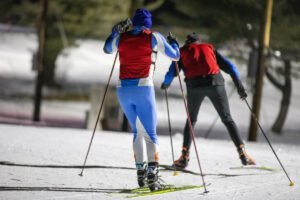
Classic cross-country skiing technique involves a kick-and-glide movement. Start by planting one ski firmly in the snow and then push off with the other ski, transferring weight onto the gliding ski. As you glide, bring the gliding ski parallel to the planted ski and repeat the movement. It’s important to practice the correct technique and rhythm to efficiently propel yourself forward and enjoy a smooth skiing experience.
Classic cross-country skiing is a popular winter sport that provides an excellent full-body workout and a great way to enjoy the winter scenery. Mastering the technique requires practice and proper form. Here are some tips to help you improve your classic cross-country skiing technique:
- Proper Equipment: Ensure that you have the right equipment for classic skiing. This includes well-fitted boots, compatible bindings, and appropriate length and flex of skis. Consult a professional to ensure you have the right gear.
- Body Position: Maintain a relaxed and upright body position. Keep your weight centered and balanced on both skis. Bend your knees slightly and lean forward from your ankles. Avoid leaning back or hunching forward.
- Diagonal Stride: The core of classic skiing is the diagonal stride, also known as the “kick and glide.” Start by lifting your heel and engaging the kick zone (wax pocket or fishscale pattern). As you transfer your weight onto the gliding ski, push off with the opposite leg and extend your leg fully. Focus on a powerful push-off and a smooth glide.
- Arm Swing: Coordinate your arm swing with your stride. As your right leg kicks forward, swing your left arm forward, and vice versa. Your arms should swing naturally, bending at the elbow, with a relaxed grip on the poles.
- Pole Planting: As your leg pushes off, time your pole plant to maximize your power and balance. The pole should plant firmly into the snow, located slightly ahead of your foot, and angled slightly backward. Use your upper body and core to generate power from the pole plant.
- Double Poling: In addition to the diagonal stride, efficient double poling is essential for more challenging terrain and high speeds. Practice a strong and controlled push with both poles simultaneously, using your core muscles and upper body strength.
- Downhill Techniques: Learn how to control your speed and maintain balance when descending. Use a snowplow technique by widening your stance, turning your toes outward, and slightly bending your knees. Use your edges to control the speed and maintain a proper body position.
- Uphill Techniques: On uphill sections, maintain a steady pace by using a herringbone or V2 technique. This involves spreading your skis wide apart and turning your toes outward to create a V shape with your skis. Push off with the inside edge of your skis to maintain grip and ascend the hill.
- Practice and Progress Gradually: Start practicing on flat terrain before progressing to more challenging trails. Focus on one aspect of technique at a time, such as weight transfer or arm swing, and gradually combine them as you become more proficient.
- Seek Professional Instruction: Consider taking lessons from a certified instructor to fine-tune your technique. They can provide personalized feedback and help you progress faster.
Remember, mastering the classic cross-country skiing technique takes time and patience. Enjoy the process, and with practice, you will become a proficient
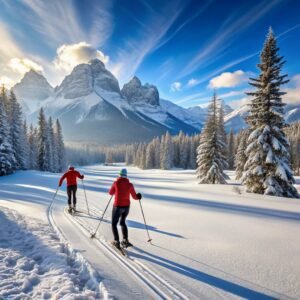
Tips for Beginners
How to Properly Wax Your Cross-Country Skis?
Waxing your cross-country skis is essential for optimal performance. Different types of wax are used depending on the temperature and snow conditions. Apply glide wax to the base of your skis to reduce friction and enhance glide. Grip wax is applied to the kick zone to provide traction. Consult a ski professional or refer to the ski manufacturer’s guidelines to determine the appropriate waxing technique for your skis.
What Should You Wear for Cross-Country Skiing?
Dressing appropriately for cross-country skiing is crucial to stay comfortable and protected from the elements. Layer your clothing to regulate body temperature effectively. A moisture-wicking base layer, insulation layer, and windproof outer layer are recommended. Wear thermal socks, insulated ski pants, and a waterproof jacket to keep your feet and upper body warm and dry. Don’t forget accessories like gloves, a hat, sunglasses, and sunscreen to complete your outfit.
When cross-country skiing, you should wear layered clothing to stay warm and comfortable. Here is a suggested outfit:
- Base Layer: Wear a moisture-wicking, breathable, and fitted base layer made of synthetic materials or merino wool. This layer helps to regulate your body temperature and keeps sweat away from your skin.
- Mid Layer: Add an insulating mid-layer such as a fleece or a softshell jacket. This layer should be warm but breathable to provide insulation without overheating.
- Outer Layer: Wear a windproof and water-resistant shell jacket and pants as your outer layer to protect you from the wind, snow, and wet conditions. Look for materials like Gore-Tex or similar technical fabrics that provide good breathability.
- Bottoms: Choose pants or tights made of breathable and stretchable materials. Avoid cotton as it absorbs moisture and can make you feel cold and uncomfortable.
- Socks: Wear tall and thick wool or synthetic ski-specific socks to keep your feet warm and dry. Avoid cotton socks as they hold onto moisture and increase the risk of blisters.
- Hat or Headband: Cover your head and ears with a warm hat or a headband made of fleece or wool to preserve body heat.
- Gloves: Use insulated, waterproof, and windproof gloves or mittens to protect your hands from the cold and wind. It is preferable to have separate ski gloves and liners to provide extra warmth and flexibility.
- Neck Gaiter or Buff: To protect your neck and face from cold winds, use a neck gaiter or a multifunctional buff that can be pulled up to cover your mouth and nose if needed.
- Sunglasses: Wear sunglasses with UV protection to shield your eyes from the sun’s glare on the snow. It is also essential to protect your eyes from wind and snow.
- Ski Boots: Use properly fitting ski boots that provide ankle support and are compatible with the type of cross-country ski binding you are using.
Remember to adjust your clothing layers based on the weather and intensity of your activity to prevent overheating or feeling too cold.
What are Some Common Mistakes to Avoid as a Beginner?

As a beginner, it’s natural to make some mistakes while learning to cross-country ski. One common mistake is leaning back too much, which hinders balance and progress. Another mistake is gripping the ski poles too tightly, which can lead to arm fatigue. It’s important to maintain a relaxed posture, engage your core muscles, and find a comfortable grip on the poles. Additionally, avoid trying difficult trails or terrain that is beyond your skill level. Start with easy trails and gradually progress to more challenging ones.
As a beginner, there are certain mistakes you should try to avoid in order to maximize your learning and progress. Here are some common mistakes to watch out for:
- Setting unrealistic goals: It’s important to set achievable and realistic goals. Pushing yourself too hard initially can lead to burnout or discouragement.
- Neglecting the basics: Don’t rush into advanced concepts without learning the fundamentals. Building a strong foundation is crucial for long-term success.
- Skipping practice: Consistent practice is key to improving your skills. Avoid the temptation to procrastinate or skip practice sessions.
- Not seeking guidance or feedback: It’s beneficial to seek the guidance of experienced individuals who can provide feedback and help you correct your mistakes. This could be a teacher, mentor, or online community.
- Focusing on quantity over quality: Quality practice and understanding are more important than simply completing a high number of tasks or exercises. Strive for mastery before moving on to new material.
- Comparing yourself to others: Everyone progresses at their own pace. It’s easy to get discouraged by comparing yourself to others who may be more advanced. Remember that everyone starts as a beginner.
- Overloading yourself with information: Trying to learn too many new things at once can be overwhelming. Take it step by step and focus on one topic or skill at a time.
- Giving up too easily: Learning something new can be challenging. It’s important to persevere through difficult times and not give up easily. Embrace mistakes as learning opportunities.
- Not diversifying your learning resources: Relying solely on one source for learning can limit your exposure and understanding. Utilize a variety of resources such as books, tutorials, online courses, and practical applications.
- Neglecting continuous learning: Avoid complacency and the belief that you’ve learned enough. Continuously seek new information, techniques, and ways to improve your skills.
Benefits of Cross Country Skiing
Cross country skiing offers numerous health benefits. It is a great cardiovascular workout that improves endurance, burns calories, and strengthens the muscles of the lower body, including the thighs, calves, and glutes. It also engages the core and upper body, making it an excellent full-body workout. In addition to the physical benefits, cross country skiing is a low-impact sport that is gentle on the joints, making it suitable for people of all ages and fitness levels. It is also a wonderful way to connect with nature and relieve stress.
- Full-body workout: Cross country skiing engages all major muscle groups, providing a comprehensive cardiovascular and muscular workout. It strengthens the core, legs, glutes, arms, and upper body.
- Low impact: It is a low-impact exercise that reduces stress on joints, making it an ideal choice for people with joint issues or those recovering from injuries.
- Burn calories: Cross country skiing is an excellent calorie burner. It can burn up to 800-1,200 calories per hour, making it an effective weight loss activity.
- Cardiovascular health: It improves cardiovascular fitness by increasing heart rate and lung capacity, promoting a healthier heart and reducing the risk of heart diseases.
- Increases endurance: Regular cross country skiing improves stamina and endurance, making daily activities easier and reducing fatigue.
- Balance and coordination: The movement involved in skiing requires balance, coordination, and core strength, enhancing overall body control and stability.
- Mental health benefits: Being outdoors in nature, especially during winter months, has proven mental health benefits. Skiing releases endorphins, the feel-good hormones, which can reduce stress, anxiety, and improve overall mood.
- Social activity: Cross country skiing can be a group or family activity, providing an opportunity for social interaction, bonding, and shared experiences.
- Accessible: It can be done in various terrains, including groomed tracks, backcountry trails, or even on frozen lakes. It can be enjoyed by people of all ages and fitness levels.
- Winter sports alternative: Cross country skiing offers an alternative winter activity for those who do not enjoy or have access to downhill skiing or snowboarding. It allows individuals to enjoy the winter landscape and stay active during colder months
Cross Country Skiing Safety Precaution

- Wear appropriate clothing – Dress in layers to stay warm and dry during your ski. Wear moisture-wicking base layers, insulating mid-layers, and a waterproof outer layer to protect yourself from cold and wet conditions. Also, wear a hat, gloves, and warm socks to prevent frostbite.
- Use proper equipment – Make sure your skis and boots fit properly and are suitable for your skill level. Have your skis regularly waxed and sharpened for optimal performance and control. Use ski poles that are the correct length and adjust the straps to fit your wrists comfortably.
- Know and obey trail rules – Familiarize yourself with the rules and etiquette of the ski trail you plan to use. Follow designated routes and signs, and yield to skiers ahead of you. Be aware of the recommended skill level for each trail and choose one that matches your ability.
- Check weather conditions – Before heading out, check the weather forecast and be prepared for any changes. Avoid skiing during severe weather conditions, such as heavy snowfall, strong winds, or extreme cold.
- Stay hydrated and nourished – Bring water and snacks to stay hydrated and maintain energy levels during your ski. Pack high-energy foods like trail mix, energy bars, or dried fruit.
- Inform others of your plans – Let someone know where you are going and when you expect to return, especially if you are skiing alone. This way, they can raise the alarm if something goes wrong.
- Be cautious of wildlife – Cross country skiing often takes place in remote areas, and encounters with wildlife are possible. Be aware of your surroundings and keep a safe distance from any animals you may encounter.
- Learn and practice proper technique – Take lessons or practice proper skiing techniques to ensure you have good control and balance. This will help you avoid falls and injuries.
- Be aware of your limits – Do not push yourself beyond your fitness level or skill level. Start with shorter and easier trails and gradually progress as your abilities improve.
- Carry a first aid kit – Always have a basic first aid kit with you in case of minor injuries. Include items like bandages, adhesive tape, antiseptic wipes, and pain relievers.
Support Us with Crypto!
If you enjoy our content and want to help keep this site running, you can support us with crypto.
Your support is appreciated!

Tron Network: USDT (TRC20)
Exploring Different Trails and Terrain
Where to Find Groomed Trails for Cross-Country Skiing?
Groomed trails are specially prepared tracks for cross-country skiing. They provide a smooth surface and are marked for different difficulty levels. Many ski resorts, national parks, and recreational areas offer groomed trails for cross-country skiing. Check with your local ski centers, tourist information centers, or online resources to find the best groomed trails in your area.
Tackling Uphill and Downhill Sections during Cross-Country Skiing
Uphill and downhill sections add an extra challenge to cross-country skiing. When tackling uphill sections, use the herringbone technique. Place your skis in a V-shape, with the tips of the skis pointing outward, and dig the edges into the snow to prevent sliding backward. For downhill sections, lean slightly forward, keep your weight centered, and use a snowplow or wedge technique to control your speed and maintain balance.
What are the Best Tips for Cross-Country Skiing on Flat Terrain?
Flat terrain offers an opportunity to enjoy a smooth, rhythmic glide. Make sure to maintain a steady pace, transferring weight from one leg to the other with each stride. Keep your eyes focused ahead and use your arms and poles to enhance balance and propulsion. Remember to stay relaxed and let the skis glide effortlessly across the snow.
Improving Your Skills and Progressing as a Cross-Country Skier
Should You Take Lessons from a Professional Ski Instructor?
Taking lessons from a professional ski instructor can greatly accelerate your learning process and improve your technique. Ski instructors have the knowledge and experience to teach proper ski techniques, provide valuable feedback, and help you set and achieve your skiing goals. They can also teach you advanced skills such as navigating challenging terrain and techniques for efficient skiing.
How to Choose the Right Ski Boots and Bindings?
Choosing the right ski boots and bindings is crucial for comfort and performance. Visit a reputable ski shop or consult a ski professional to get properly fitted for ski boots. The boots should provide a snug fit and sufficient ankle support. Bindings should be compatible with your boots and skis. Consider your skiing style and objectives when selecting the appropriate binding system for your cross-country skiing adventures.
How to Herringbone Up Steep Hills in Cross-Country Skiing?
Herringboning is a technique used to climb steep hills in cross-country skiing. Start by placing your skis in a V-shape, with the inside edges gripping the snow. Dig the edges into the snow, press down firmly, and push your skis outward. Transfer weight onto the uphill ski while maintaining a stable balance. Practice this technique on gentle slopes before attempting steeper hills.
Top 5 Places for Cross-country Skiing in Canada
1. Whistler Olympic Park, British Columbia
Located in the Callaghan Valley, Whistler Olympic Park is a premier destination for cross-country skiing enthusiasts. It offers over 90 kilometers of groomed trails set in the stunning backdrop of the Coastal Mountains. The park was one of the venues for the 2010 Winter Olympics and offers trails for all skill levels.
2. Gatineau Park, Quebec
Just a short drive from Ottawa, Gatineau Park is a cross-country skiing paradise with over 200 kilometers of trails. The park’s varied terrain includes challenging climbs and scenic forest paths, making it perfect for both beginners and experienced skiers. The park also hosts the annual Gatineau Loppet, Canada’s largest international cross-country ski event.
3. Lake Louise, Alberta
Lake Louise in Banff National Park is known for its breathtaking scenery and world-class cross-country skiing trails. The area offers more than 80 kilometers of groomed trails that wind through dense forests and open meadows. The stunning views of the Rocky Mountains and the iconic Fairmont Chateau Lake Louise add to the experience.
4. Sovereign Lake Nordic Centre, British Columbia
Located near Vernon, the Sovereign Lake Nordic Centre is part of the larger SilverStar Mountain Resort. The centre boasts over 100 kilometers of expertly groomed trails, suitable for all skill levels. It is renowned for its reliable snow conditions and hosts numerous national and international competitions.
5. Mont-Sainte-Anne, Quebec
Mont-Sainte-Anne, near Quebec City, is one of the oldest and most prestigious cross-country ski destinations in North America. The area features more than 200 kilometers of trails, including a 7.5-kilometer illuminated trail for night skiing. The varied terrain and well-maintained trails attract skiers from around the world.
Also read our recent blog – Best Places for Camping in Manitoba 2024
Ultimate Beginner’s Guide to Cross-Country Skiing: 2024 – FAQ
-
What is cross-country skiing?
Cross-country skiing, also known as Nordic skiing, is a popular winter sport that involves traveling across snow-covered terrain using skis and poles. It is a great way to explore the outdoors and stay active during the winter months.
-
What equipment do I need to start cross-country skiing?
To start cross-country skiing, you will need skis, poles, and boots specifically designed for cross-country skiing. It is important to choose equipment that is suitable for your skill level and the type of skiing you plan to do, whether it’s classic skiing or skate skiing.
-
How do I choose the right ski equipment?
When choosing ski equipment, it is important to consider factors such as your weight, skiing ability, and the type of terrain you will be skiing on. It is recommended to consult with a professional ski shop or instructor to ensure you select the appropriate equipment for your needs.
-
Can I cross-country ski if I am a beginner?
Absolutely! Cross-country skiing is a sport that caters to all ages and skill levels. There are beginner-friendly trails and lessons available to help you get started. Don’t worry if you don’t have any prior experience, with the right instruction and practice, you can quickly become comfortable on the skis.
-
Do I need ski lessons?
While it is possible to teach yourself how to cross-country ski, taking lessons from a qualified instructor can significantly accelerate your learning curve and help you develop proper technique. Ski lessons can also provide you with valuable safety information and tips for a more enjoyable experience on the trails.
-
What are the different types of cross-country skiing?
There are two main types of cross-country skiing: classic skiing and skate skiing. Classic skiing involves a diagonal stride motion, while skate skiing requires a side-to-side skating motion. Both styles have their own techniques and equipment requirements.
-
How do I wax my cross-country skis?
Waxing your cross-country skis helps optimize glide and grip on different snow conditions. The type of wax you use will depend on the temperature and snow conditions. It is recommended to consult with a ski shop or instructor for guidance on waxing techniques.